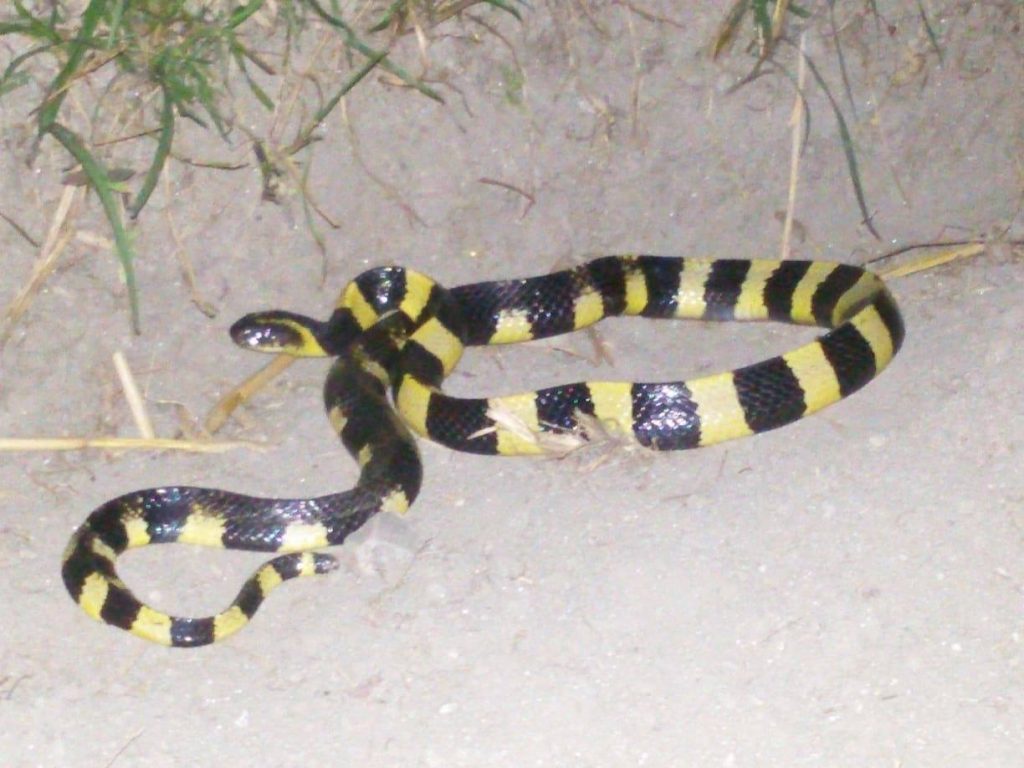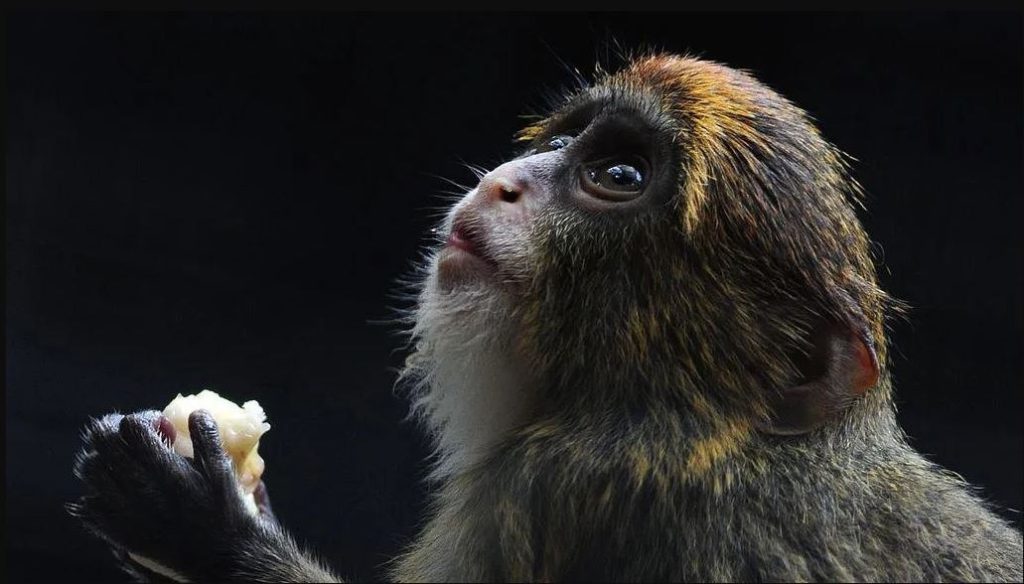Snakes are out for summer: Keep your distance


As summer begins, many burrowing animals those are going for hibernate are coming out for activation. It was 7:15 PM evening and a dim light around the house was lighting. As my brother was coming out from the room, he saw a black and yellow spotted, snake around 2.5 m long, Before that this snake was seen frequently but my mother always said us that we have to love because it is inactive .
My Mother used to say this snake move around the house, and she used to see occasionally in kitchen garden during cleaning and while going to cowshed i.e. (Gwali- Typical Nepali words where cow and other domestic animals are kept) after certain interval of time my brother once again saw a snake few meter distances from the home.
While chatting in social media he share me a snake picture then I was surprised to see this snake once again in natural habitat I felt very proud that my house and its periphery is good habitat for such a mystery piece of nature.
The color combination is very attractive and shining. I am unknown about this snake but I am very much excited to know about it and I was started for literature review regarding this species and found some of the information.
Potential cause of declination of Snake in Nepal, as well world Due to Habitat loss due to Developmental works including haphazard construction of road, Building houses, Excessive use of chemical fertilizers that has disturb in food chain, Use of modern Agricultural tools that kills or destroy the home of the snake.
What is a snake?
Snakes are limbless reptiles having an elongated body covered with scales which are arranged in rows. By observing the arrangement of their body scales expect can judge the which types of species is this .They are vertebrate animals and are cold- Blooded animals and under normal circumstances they have to regulate their body temperature by choosing appropriate places in their environment (e.g., by sun bathing or hiding in holes), so they are very sensitive to weather and climatic changes and other ecological or environmental conditions.
More than 3400 different species of snake found on the earth. Except Antarctica snake can be found on the entire continent. And they have conquered the most divergent environments from the mountains of the Himalayas to the coral reefs of the Pacific Ocean Most snakes reproduce by laying eggs but some species give birth to fully developed young. Certain species of snake like pythons or the king cobra even guard and protect their eggs.
Ecological role
Snakes exclusively eat other animals, and many species are capable of swallowing prey that is very big or bulky compared to their own body. By controlling the number of other animal species, and by serving as food to others like birds of prey and other predators (e.g., mongoose), snakes play an important role in the natural ecosystems and artificial agro-ecosystems. For farmers, snakes are very useful because they help to control rodent populations by eating the rats and mice that would otherwise damage crops or eat stored food. Most species of snake are harmless for humans. Many have no venom at all, and they either kill their prey by constriction or by pressing it to the ground, many others produce secretions in specialized oral glands that help them to immobilize, kill and/or digest their prey and to act against harmful bacteria.
From a biological point of view, these oral gland secretions are usually called venoms (and the glands in which they are produced, venom glands) if the snakes use them to quickly immobilize or kill their natural prey. This is usually achieved if the snakes do not only have toxic oral gland secretions, but also an effective venom apparatus to deliver these into their prey or enemy. The teeth of snakes play a key role in this.
Bungarus fasciatus Banded Krait (English), Gangawari, Panhelo-kalo Chure Sarpa, Kanthamala, Laxmi Sanp, Raja Sanp, Maher, Gwala Sarpa, Ahiriniya Sanp (Nepali) Identification: Usually 1-2 m (up to 2.25 m) long, hatchlings about 30-35 cm. Broad black and light rings of similar width on body and tail. Light rings yellow in adults, cream to white in juveniles, extending completely across belly.
Tail tip blunt, not pointed, sometimes mistaken for a second head. Body triangular, vertebral column forming distinct ridge along top of the back. Fifteen rows of scales across back, scales along vertebral ridge much larger than bordering scales. Scales on lower side of tail undivided.
Distribution and habitat: Likely throughout the lowlands and lower mountains of Nepal. Elsewhere, from India east to China and south to Indonesia. Known from coastal and mangrove swamps at sea level to mountain forests at 2300 m altitude (in Myanmar). Prefers wet habitats and vicinity of water (e.g., ponds, streams, rice fields, near villages). Medical importance and behaviour: Common snake, active at night, often seen by people. Its favorite food is snakes including venomous ones.
Usually hides head under body if disturbed, hissing and making jerking movements. Bites appear to be rare in Nepal but envenoming by this species is very dangerous and can result in death in a short time. Juvenile Banded Kraits (Bungarus fasciatus) have a pattern of white to cream and black rings on the body. The white rings become yellow as the snakes grow.
Venom effects: The major dangerous effect of B. fasciatus venom is progressive paralysis of the peripheral nervous system, leading to respiratory paralysis and death due to asphyxia. Systemic muscle damage with myoglobinuria, acute renal failure and hyperkalaemia has caused death in a case suspected to have been caused by this species in northwestern Bangladesh. Thus, both neurotoxic and myotoxic envenoming and their complications should be anticipated. 6121 cases of Snake bite has been reported in Nepal and 33 deaths due to snake bite has been reported this year 2073/74 Annual Report of Department of health services 2073/74
Some of the preventive measures if we are bitten by a snake are as below :
1. Don't panic. Most snakes are not dangerous, and even those that are dangerously venomous often do not inject venom when they bite a person.
2. Don't risk further bites or delay appropriate treatment by attempting to search, capture or kill the snake. However, if the snake is already killed, it should be carried safely along with the patient to the treatment center for identification.
3. Immobilize the bitten limb with a splint or sling and keep it still.
4. Don't run. If possible, let others carry you immediately (preferably by motor vehicle) to the nearest health center where anti-snake venom serum is available. Using a motorcycle will help to save time.
5. Don't cut burn or suck the bite site or the bitten body part.
6. Don't use herbs, chemicals, ice/cool packs or electric shocks.
Mr. Mahendra has graduated in Environment Science

 Nature Khabar
Nature Khabar




Feedback